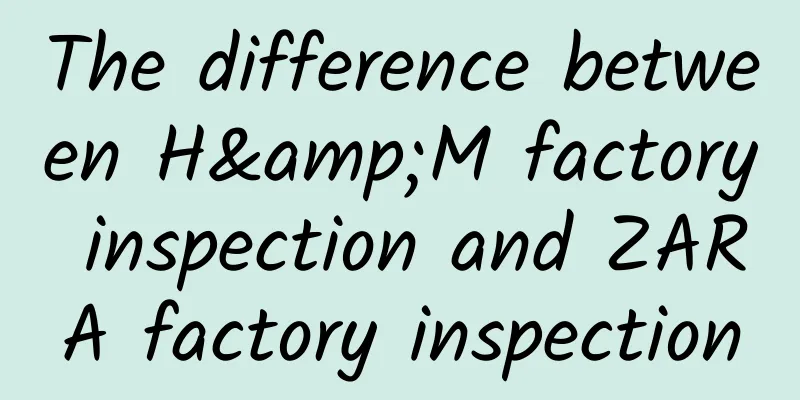The difference between H&M factory inspection and ZARA factory inspection

|
H&M uses dual supply chains to balance efficiency and cost, while ZARA relies on its ultra-fast supply chain to conquer the world. These two fashion industry giants compete for glory on stage, but they each have their own ways behind the scenes. H&M strives to find a profit balance between efficiency and cost On the exterior wall of Jialidu Commercial Building on Huaihai Middle Road in Shanghai, a huge poster of H&M attracts the attention of every passerby. On April 12, this fashion retail giant from Sweden will open its first flagship store in the mainland here. On Nanjing West Road, a few subway stops away, H&M's arch-rival, the flagship brand ZARA under the Spanish Inditex Group, is selling hot. This ZARA store covers an area of about 1,500 square meters, but it achieved a record of more than one million yuan in single-day sales during this year's Spring Festival. ZARA and H&M have in common that they open stores in prime locations, are close to luxury goods, have bright stores, adopt the concept of "small quantities, multiple styles, and affordable prices", and respond quickly to popular fashions. With these strategies, they have grown rapidly in the past few years: in 2003, ZARA became the world's third largest clothing retailer, and its global operating income reached 4.6 billion euros in fiscal 2004, with a profit margin of 9.7%, exceeding the 6.4% profit margin of GAP, the largest clothing chain in the United States. As the largest clothing retailer in Europe, H&M has increased its turnover by 100%, the number of branches by 75%, and its earnings per share by 262% in the past five years. Its total pre-tax profit in fiscal 2005 reached 13.553 billion Swedish kronor (about 118.859 billion euros). "Being a follower of fashion, not a creator" means effectively controlling the lead time (the time from product design to sales). Data shows that ZARA's lead time is 15 days, H&M's lead time is as fast as 20 days, and the usual lead time for domestic clothing companies is around 90 to 120 days. ZARA and H&M are a pair of rivals that are often mentioned in the fashion industry. On stage, they compete for glamour, but behind the scenes, they compete for supply chain. ZARA is proud of its extremely fast supply chain. Even when opening a store in China, far away from Spain, it miraculously maintains an extremely fast speed of 15 days. H&M, which believes in the trinity of "time, quality and price", uses two supply chains and strives to find a profit balance between efficiency and cost. Compared with ZARA, H&M's fastest lead time is 5 days later. However, the cost of these 5 days has given H&M a cost advantage - "its clothing prices are 30%-50% cheaper than ZARA's." ZARA conquers the world with its “ultra-fast” supply chain In the "three-in-one" concept advocated by H&M, cost is the highest priority, so its production sites are always transferred to regions with excellent labor, low wages and high-quality production. From the mid-1960s to the 1970s, H&M successively established production sites in Northern Europe, Southern Europe, East Asia, etc. It does not own its own factories, but outsources all production to 700 independent suppliers in 22 countries in Europe and Asia. How to establish close ties with these suppliers distributed all over the world? H&M has adopted the strategy of setting up production offices at the production sites to coordinate the relationship between the internal procurement department and suppliers and to develop new suppliers. "The production office must ensure that the right suppliers are found and that the products are produced at a low price with good quality." said an H&M staff member in Shanghai. Based on procurement cost considerations, H&M places 60% of its production in Asia and the rest in Europe. Generally speaking, conventional fashion and children's clothing are produced in Asia, and small-volume and popular clothing are usually given to European suppliers. “Not all products have a shorter lead time. Our lead times range from two to three weeks to six months. In fact, a quick lead time is not necessarily the most advantageous. An appropriate lead time helps us find the best balance between price, time and quality.” While ZARA is committed to creating the myth of speed, H&M Group CEO Rolf Eriksen has revealed its unique business strategy. This strategy tells a classic story of playing with time and cost. Therefore, H&M designed two supply chains: an efficient supply chain that controls Asian production and a quick response supply chain that controls European production. H&M uses an information system called OFS (Offer Follow up System) to track the production plan of the supply chain. For Asian suppliers that make basic styles, H&M's efficient supply chain strategy is to meet product supply while keeping costs to a minimum, so communication between it and suppliers is often conducted through email. In this supply chain, more work is monitored by employees in the production office with standardized processes. "H&M gives us an extremely low price for OEM, but the volume is huge!" said Hu Hongxia, general manager of Shanghai Huayuan Knitting Fashion Company. Huayuan Company has joined H&M's supplier list since 1994. Unlike OEM for other foreign brands, H&M only cooperates with suppliers that have joined its list. The establishment of thresholds is conducive to ensuring quality and coordinating cooperative relationships. Huayuan mainly provides OEM sweaters for H&M. According to Hu Hongxia, the business volume of each order from H&M is at least 100,000 pieces. Generally speaking, it takes at least two months from sample making to delivery for an order of 100,000 pieces. "H&M sends us the design drawings via email. We first make samples for them to confirm. After the modification opinions are returned, we start to produce promotional samples, usually more than 20 pieces. After confirmation again, we start mass production." How can H&M headquarters in Sweden know the production progress of Asian suppliers? "H&M staff will come to the factory to inspect the goods at the beginning, middle and end of production." Hu Hongxia said. After the inspection, H&M employees will enter the production progress into the OFS system and report to the Swedish headquarters. When the products are produced, Huayuan will send the goods to the customs, and the third-party logistics company will deliver them to H&M. "Generally, goods are shipped by sea, which is slow but the most economical." Huayuan has its own supply chain system, and it has established a close relationship with its upstream wool yarn mills. "When the sales sample is determined, the order quantity of H&M will come out at the same time. The wool yarn mill can calculate how much raw materials are needed and start preparing wool yarn." Although H&M's efficient supply chain is cost-oriented, in order to improve efficiency, it still tries to connect each link as closely as possible. For those popular clothes, H&M places orders in Europe to respond to market demand with a fast-response supply chain. In addition to using the OFS system to track the production plans of European suppliers, all departments of H&M headquarters and 22 production offices communicate based on the ICT (Information and Communication Technologies) platform. At H&M headquarters, the design and procurement departments work together. Each design concept has a team of designers, buyers, assistants, pattern makers, financial directors and department managers, so that they can strike a balance between price, market feedback and fashion at the early stage of design. When the design sketch comes out, the ICT platform can distribute the data to the corresponding departments, or even the 22 product offices, in order to determine the appropriate production site and supplier. "When deciding where to produce a product, we must not only consider cost, but efficiency is also an important factor. If a product needs to be put on the market quickly, we will choose a production site that is closer to the market," said an H&M staff member. Flexible procurement is the core of H&M's quick response supply chain. Generally speaking, clothing companies have to make seasonal purchases, but this model was broken by H&M in 1968 - its buyers adopted a strategy of purchasing 12 times a year to quickly respond to fashion trends. In order to support the flexible procurement model, the ICT platform has made a great contribution. On the ICT platform, H&M's procurement department and sales department can work closely together; all stores can also know each other's sales on the ICT platform and transfer goods in a timely manner; the procurement and logistics departments can track the sales and inventory of each product to facilitate timely replenishment. "Takten (synchronization)" is the concept proposed by H&M's first CEO, that is, to update the detailed list every week so that each procurement department and each store can know how much each product has been sold. "This concept has been implemented in ICT to this day." An internal report of H&M pointed out that "ICT has established a circular information feedback mechanism for H&M, and the information on sales, inventory, procurement plans and production capacity has become completely transparent." In the logistics link, in order to avoid overproduction and backlogs, H&M's central logistics system closely follows the sales progress of each product through ICT. Products produced by H&M suppliers are usually shipped to the central warehouse in Hamburg, Germany for sorting and delivery, but if the product is for a certain regional market, H&M can respond quickly through ICT and deliver the product directly to the branch in that country or even directly to the store. The ICT-based quick-response supply chain bought H&M valuable time and naturally stimulated sales. In the fall of 2004, mini skirts were very popular, and H&M's orders for a popular black wool skirt tripled, all thanks to its quick-response supply chain. "New products arrive in stores every day," which makes H&M very attractive to fashion fans. It is worth mentioning that H&M has also been innovating in the expansion of sales channels. Although its current sales channels are still mainly direct stores, its catalog sales and online sales are growing continuously. In 1980, H&M acquired Rowells and began to sell catalogs in Sweden, Finland, Norway and Denmark; in 1998, H&M opened an online store in Sweden, and then opened online sales in Finland, Norway and Denmark. Based on the initial success, in the fall of 2006, the Netherlands became the first country outside the Nordic region to open online sales. "In the fall of 2007, Germany and Austria will start online sales." Rolf Eriksen introduced. Ultra-fast supply chain 15 days! This is the number that ZARA is being chased by the clothing industry. H&M is good at "dancing" between cost and speed, while ZARA focuses on the rapid response of the supply chain. This Spanish company, favored by Morgan Stanley, has become a classic of the clothing industry's ultra-fast supply chain with its 15-day lead time. Unlike H&M, ZARA places most of its production in Europe. In Spain, ZARA has 22 factories, 50% of its products are produced by its own factories, and 50% of its products are completed by 400 suppliers. 70% of these suppliers are located in Europe, and the rest are distributed in Asia. This geographical location is also to maintain the responsiveness of its supply chain. Similarly, in order to speed up the flexibility of the entire supply chain, ZARA controls the suppliers of raw materials such as fabrics and dyes from the upstream of the supply chain. They are always on standby as semi-finished products. Once ZARA issues a production order, these raw material suppliers will go into production, thus avoiding time waste to the greatest extent. In the cutting and pattern making process, ZARA's factory uses the JIT (Just In Time) system jointly developed with Toyota. Unlike the large-scale production of the large-scale clothing industry, ZARA's production lines are small-batch assembly lines. "Small batches and multiple varieties" is exactly the production model of Toyota Motors, and ZARA has transplanted it to the clothing industry. With the help of the JIT system, ZARA can customize the production process and achieve flexible production. When the fabrics are cut, they will be sent to small factories and family workshops in Spain or Portugal for sewing and processing. Generally speaking, each production unit only accepts one style and is assigned one shift, so that the output of a certain type of clothing can be quickly increased or reduced. In terms of logistics, ZARA, like H&M, relies on an efficient central distribution center, which is located at the Spanish headquarters and distributes products to all parts of the world. "ZARA has a web-based supplier management platform, through which the headquarters can monitor the entire process from shipment, customs clearance, customs clearance to the headquarters, and even track the dynamics of the logistics company." An IT manager of ZARA introduced. This platform also saves valuable time for ZARA. In addition to improving logistics efficiency, the Internet can also eliminate the inconsistency of work rhythm caused by time difference. Information in the clothing industry is traced back in reverse, that is, from the front end of the market to the upstream. H&M's "treasure" is ICT, but how does ZARA, which has more than 2,000 stores around the world, understand market conditions in a timely manner so that it can respond quickly? Each ZARA store is equipped with an independent information system. Every night, the ZARA headquarters in La Coruna in northwestern Spain exchanges a large amount of raw data with each store. The data is as detailed as the number of orders, size, color, quantity, sales time, payment method, discount information, price adjustment, etc. for each product. After that, each department will break down the data according to needs to make judgments on local markets. Especially for the design department, sales data from each store can help them analyze best-selling or slow-selling products as a reference for the design of new products. In order to be closer to the market, ZARA adopts a team design model composed of buyers, designers, and marketing specialists. In addition, the PDA in the hands of each ZARA store manager is also a powerful tool for obtaining market information. In the ZARA store on Nanjing West Road in Shanghai, store manager Joise often sends orders to the Spanish headquarters through her PDA, and she can also know the recommended order quantity given to her by the headquarters on her PDA. Like store managers around the world, Joise can communicate directly with the product managers at the headquarters through PDA. Through IT, ZARA has established a closed communication mechanism, allowing a large amount of information to flow smoothly in the supply chain, enabling direct communication between design, procurement, production and sales. Adopting a single rhythm for the supply chain is also an important rule of ZARA's ultra-fast supply chain. Wednesdays and Saturdays are fixed arrival dates for ZARA stores. Due to the rapid growth in performance, ZARA has quickly opened three stores since entering mainland China last year, and the fourth store is about to open. Whether in Beijing or Shanghai, ZARA still maintains a consistent supply chain rhythm. In addition, "regardless of cost" insists on using air transport to deliver goods, which also allows ZARA to maintain "extreme speed". In Europe, ZARA's clothes are sent from the logistics center and can reach the store in 24 hours; in China and the United States, this number is 48 hours; in Japan it is 72 hours. At the ZARA store on Guanghua Road in Beijing, the clerk Smart often persuades those fashionable men and women who come here to come back another day when closing the store at night, but there are always unwilling customers who beg Smart to give them a break. But even though Smart is good-tempered, he can't do anything, because after 10 o'clock every night, each ZARA store begins to exchange data with the headquarters, and all transactions will be stopped. In ZARA, a huge clothing machine with precise operation and standardized processes, personal feelings cannot change any operation. |
<<: HM Factory Audit-Quality Control Manual Contents
>>: Declaration of Implementation of the Obligations of the BSCI Code of Conduct
Recommend
How much do you know about FSC forest certification? The most complete answer is here
Many FSC certified export companies have consulte...
Best eBay Selling Tips
Many sellers who have just started operating on e...
Product Description--"Amazon Long Description"
Product Description is an important part of optim...
What is the Quanzhou Cross-border E-commerce Association? What are the requirements to join the Quanzhou Cross-border E-commerce Association?
What is Quanzhou Cross-border E-commerce Associat...
The national carbon market is expected to gradually expand as it turns one year old
The national carbon emission trading market is ab...
How about Jiuyi Network? What are the service advantages of Jiuyi Network?
How about Jiuyi Network? Jiuyi Network Technology...
What is meesho? What are the advantages of meesho platform?
What is meesho? Meesho is an Indian-origin social...
eBay store operation agent? Let's see if we can find one first~
Judging from the current store growth trend, most...
What is SEO? How to do cross-border e-commerce SEO?
What is SEO? Search engine optimization, commonly...
Majestic — Powerful link analysis tool
What is Majestic? Majestic surveys and "maps...
WCA factory inspection key points - checklist English version (below)
WCA factory inspection checklist: 15. Local minim...
FSC certification: "Forest packaging trend" is sweeping the country
Thousands of milk and beverage cartons are discar...
GRS factory audit checklist company documents
The contents of the relevant company documents in...
What is Pricefall? What are the costs of Pricefall?
Pricefall operates in the United States. It used ...
What is Slickdeals? How to register an account on Slickdeals?
What is Slickdeals? Slickdeals.net is a shopping ...









